Garnet Jewelry from the Czech Republic (Bohemia)
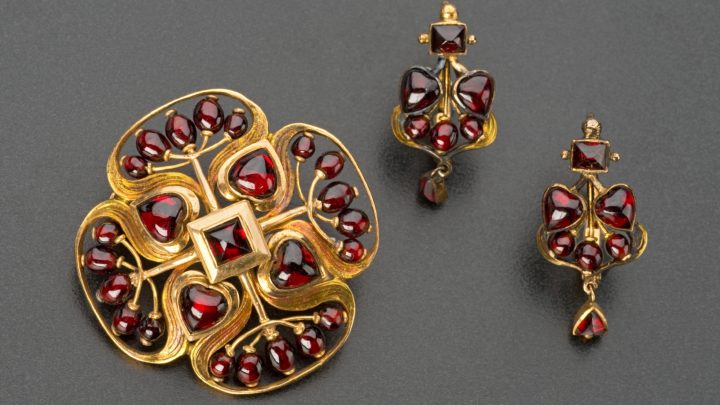
Introduction
Garnets mined in Bohemia are of the variety called pyrope (from the Greek words pyr for “fire” and ops for “eye”). Of a rare high quality found in Central Bohemia in the north of the Czech Republic, the Bohemian garnet’s color ranges from fiery-red to ruby-red, and its deep coloring is not lost even in the smallest, two-millimeter grains. This semi-precious gem is well known as the January birthstone.

The brilliant sparkle of the Bohemian Garnets is due to their excellent clarity, transparency and high refraction of light and therefore gained popularity in Europe in the 18th and 19th century as well as during the Victorian age. The traditional handcrafted Bohemian design places great emphasis on the arrangement of the garnets which dominate over the metal in each individual piece of jewelry.
Antique Jewelry Information
The stones are used not alone for jewelry and for ornamenting gold and silver plate, but also extensively for watch jewels and for polishing. The introduction of larger scale manufacturing of garnet jewelry created mass-produced machine pressed metal settings and garnets. It also required the introduction of a broad choice of to obtain commercial success. Garnet rings were generally made of facetted, rose or cabochon cut Garnets in 14 or 18 kt gold (George Frederick Kunz: Rings for the Finger).
In the late 19th century it was already pointed out that the larger Pyropes were typically brilliant-cut, resulting in very bright (red) stones, whereas the very small stones were usually rose-cut. In particular the mass produced jewelry contained the inferior quality garnets. (Marcell Smith: Diamonds and Precious Stones)
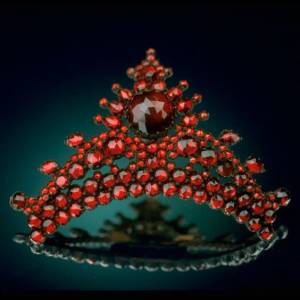
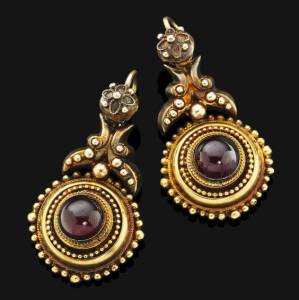
Production in the 19th and 20th century
Although the Bohemian garnets have been known for many centuries, the industry of mining and cutting them on a large scale is said not to have assumed any special proportions until the advent of foreigners to Karlsbad. They spread a knowledge of the stones to other countries, and a demand sprang up which has led to the establishment of a great industry, and made Bohemia the garnet center of the world.
From the 1880’s the manufacture and distribution of such jewelry was predominately concentrated in large enterprises employing dozens of men and women workers. In total there were over three thousand men employed at the end of the 19th century, in cutting the stones, and if to these be added the number of miners and gold and silver smiths occupied in the mining and mounting of the garnets, a total of ten thousand persons are estimated to have been working in the Bohemian garnet industry around the turn of the last century. (Oliver Farrington: Gems and Gem Minerals)
Mining, Geology, Gemmology
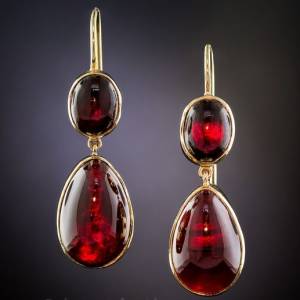
The Bohemian garnet has been mined for over 600 years mostly dug at the mines of Meronitz, Bohemia, and chiefly in the northwestern part, near Teplitz and Bilin in the Czech Republic. The garnets are found in a gravel or conglomerate of Cretaceous age, resulting from the decomposition of a serpentine. Sometimes, however, they are found in the matrix, and are then often associated with a brown opal. They are found by digging and separated by washing. Though of good quality the stones are small, those as large as a hazelnut being found but rarely.
Already in the 19th century it was determined that the elements creating the intense red color in Pyrope were Chromium and Manganese. (Smith: Gems and Precious Stones)
Educational Images From the The National Czech & Slovak Museum
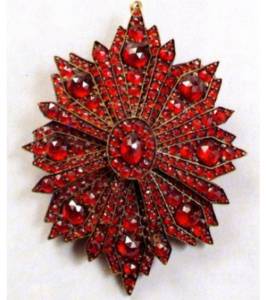
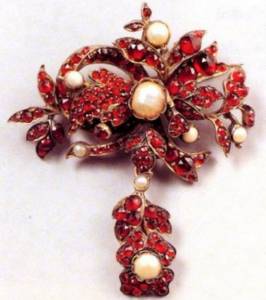

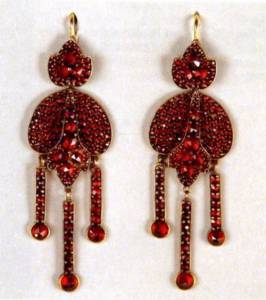
Additional comments:
Image 2: The appearance of such articles in northern Italian or German collections may well have been the result of foreign trade activities of Czech garnet dealers who annually showed their products at European trade fairs and branches abroad.
Image 3: A sensational discovery from the vaults of St. Nicholas Church in Prague, Thanks to restoration funded by the National Czech & Slovak Museum & Library, the monstrance, which is used in special Roman Catholic ceremonies, can be seen again for the first time since the exhibition in Prague in 1895. At nearly one meter tall, the curator from the National Museum, Dr. Dana Stehlíková (Stehlikova), believes it is quite likely the largest existing object decorated with Bohemian garnets. National Museum goldsmith Vladimir Cizkovsky completed the restoration work in Prague.
Image 4: Mass production manufacturing was somewhat delayed compared to other areas of design, but the Art Nouveau mass produced designs were perpetuated that much longer, for example, in picture frames.
